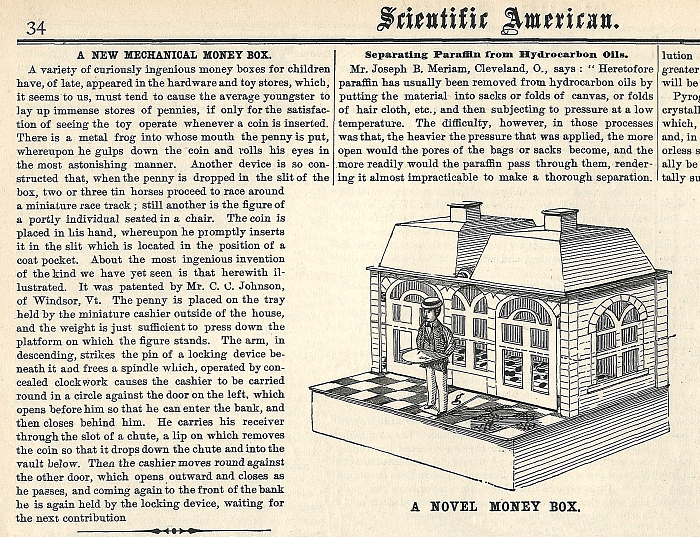Scientific American, New York, July 15,
1876

| SCIENTIFIC
AMERICAN A WEEKLY JOURNAL OF PRACTICAL INFORMATION, ART, SCIENCE, MECHANICS, CHEMISTRY AND MANUFACTURES. New York, July 15, 1876. Vol. XXXV. — No. 3. (NEW SERIES.) ( $3.20 per Annum. POSTAGE PREPAID.) A NEW MECHANICAL MONEY BOX. A variety of curiously ingenious money boxes for children have, of late, appeared in the hardware and toy stores, which, it seems to us, must tend to cause the average youngster to lay up immense stores of pennies, if only for the satisfaction of seeing the toy operate whenever a coin is inserted. There is a metal frog into whose mouth the penny is put, whereupon he gulps down the coin and rolls his eyes in the most astonishing manner. Another device is so constructed that, when the penny is dropped in the slit of the box, two or three tin horses proceed to race around a miniature race track; still another is the figure of a portly individual seated in a chair. The coin is placed in his hand, whereupon he promptly inserts it in the slit which is located in the position of a coat pocket. About the most ingenious invention of the kind we have yet seen is that herewith illustrated. It was patented by Mr. C. C. Johnson, of Windsor, Vt. The penny is placed on the tray held by the miniature cashier outside of the house, and the weight is just sufficient to press down the platform on which the figure stands. The arm, in descending, strikes the pin of a locking device beneath it and frees a spindle which, operated by concealed clockwork causes the cashier to be carried round in a circle against the door on the left, which opens before him so that he can enter the bank, and then closes behind him. He carries his receiver through the slot of a chute, a lip on which removes the coin so that it drops down the chute and into the vault below. Then the cashier moves round against the other door, which opens outward and closes as he passes, and coming again to the front of the bank he is again held by the locking device, waiting for the next contribution. — - — |

